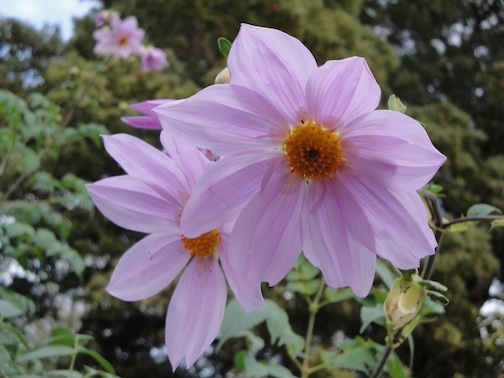How to Plant and Care for the Dahlia imperialis or “Tree Dahlia”
To all the lovely people,
I had never seen or heard of a “Tree Dahlia”until I enrolled in the Master Gardener class in 2004. I was familiar with the Dahlia tuber and grew many large and beautiful tuberous Dahlia’s over the years but this plant was new to me. Like many or even most of the Tree Dahlia’s grown by Master Gardener’s in this area the original canes most likely came from the garden of Al Derrick, a truly superior Master Gardener who has taught many of our propagation classes over the years.
A little information about the plant. Originating in Central America, the plant comes from the family: Asteraceae; Genus: Dahlia; species: imperialis. Flower size is somewhere in the 4” to 6” range and colors vary from Pink to White, Lavender, and Purple. The most common color seems to be the Purple or Lavender (at least around the central coast area). The Purple or Lavender flowers are singles and the White flowers are complex. The plants grow tall – reaching 10’-20’ in height. The canes have the appearance of Bamboo and are hollow with interior dividers every 6” to 12”. The plants flower in late September – December and attract Bumblebees and Butterflies. It is quite a site to see a couple of dozen Bumblebees flying from flower to flower in November!
Soil with a pH of 6.1 to 6.5 (mildly acidic) is preferred by the plant. They can be grown from seed by allowing the flowers to mature and dry out and then breaking them apart and collecting the seed that are similar in appearance to Zinnia seed but smaller. The usual method of propagation is by cutting the canes into pieces that include at least one dividing wall. Please see the photos for a detailed explanation.
Since the canes grow so tall they can be pruned back in mid-summer to encourage side branches if desired. They also should be protected from strong winds to avoid damage to the canes. They do well against a house or fence and like full sun and rich ground. Three of four inches of good compost added after the canes are pruned back and that will be all the plant needs until mid to late summer – then add a couple of inches of compost and you will see the results in November. If you are planting several pieces of cane at a time then the spacing should be about 3 to 4 feet because each year the plants will add more canes and increase in diameter. If a length of cane is left to lay on the ground then roots and new shoots will emerge from each section so be careful unless you want growth every 6” to 12” apart. Plants can be started in pots or directly in the garden bed. The sections root quickly and growth is fast during the season. If you don’t have a Tree Dahlia in your garden and would like to include it in your landscape ask someone who grows them for a section or two and follow the pictorial instructions below and you will have flowers next fall. Simple and easy to grow.
See the attached PDF for pictures and step by step instructions.
http://cesantacruz.ucanr.edu/files/163686.pdf
